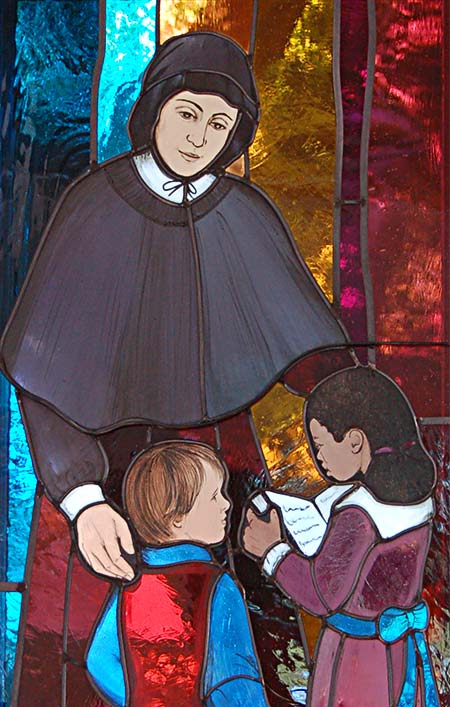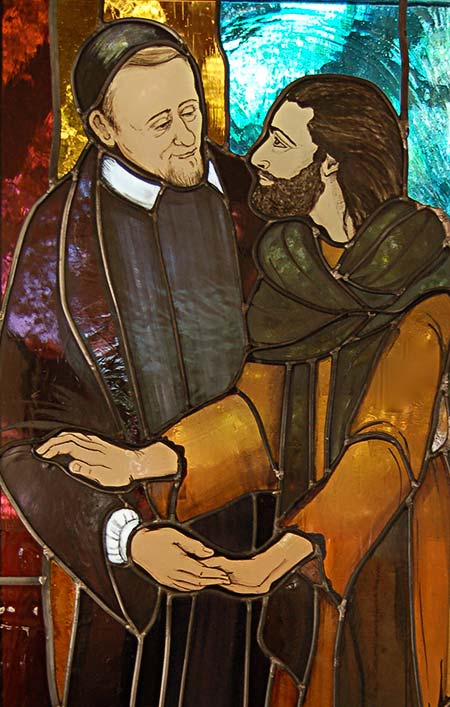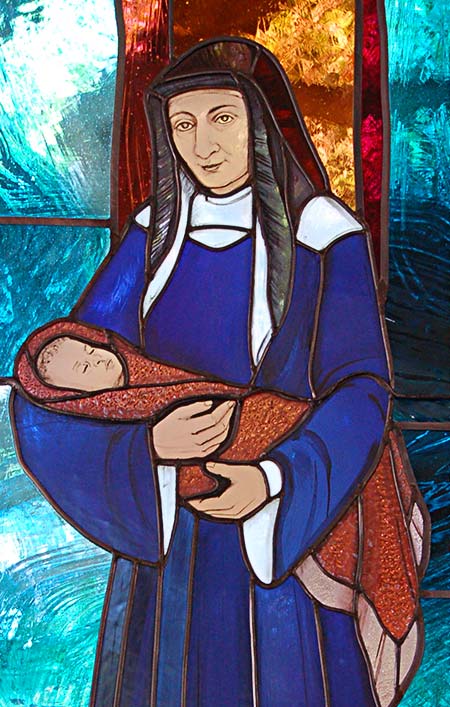Our Founders
Stained glass images © Susan Wagner Designs. Used with permission.
Saint Vincent de Paul
April 24, 1581 – September 27, 1660
Vincent De Paul was born in Pouy, Landes, Gascony, France, on April 24, 1581 to a family of peasant farmers. In his family Vincent had four brothers and two sisters. He studied theology at the University of Toulouse, was ordained a priest at 19, and completed a further year of studies in Rome, before returning to Paris and dedicating himself to serving the poor. By 1625 he had influenced a number of young men, some of the priests, to join him in forming a religious group to be called the Congregation of the Mission often known as “The Vincentians”.
St. Vincent de Paul was a skilled networker and collaborator and gave his energies and life to the needs of the poor in 17th-century war-torn France. Together with St. Louise de Marillac, a talented and sensitive friend, he organized hospitals for the sick poor, founded institutions for abandoned children, opened soup kitchens, created job training programs, taught young women to read, bettered prison conditions, and organized countless local charities in the villages throughout France. Vincent de Paul was canonized in 1737 and is popularly known as “The Father of The Poor.” With St. Louise de Marillac, he started the first religious group of women dedicated entirely to works of charity outside the cloister, a group called the Daughters of Charity.
Vincent was a man of action rather than of theory. He was a pragmatist and his spirituality was simple, down-to-earth and practical. He looked to Christ as his leader and tried to translate the Gospel message into concrete results. Besides being a practical organizer he was also a man of deep faith; a man of prayer and a mystic. The immense range of services he set up for the poor were more than mere philanthropy. They were rooted in the Gospel vision of Matthew 25 where Jesus tells us:
“Whatever you do to the least of my brothers and sisters you do it to me”
Saint Louise de Marillac
August 12, 1591 – March 15, 1660
Louise de Marillac told her Daughters:
“…above all, be very gentle and courteous toward your poor. You know that they are our masters and that we must love them tenderly and respect them deeply. It is not enough for these maxims to be in our minds; we must bear witness to them by our gentle and charitable care… As for your conduct toward the sick, may you never take the attitude of merely getting the task done. You must show them affection; serving them from the heart; inquiring of them what they might need; speaking to them gently and compassionately…”
Louise parents were not married. She never knew who her mother was but she was acknowledged and raised by her father, a member of the aristocracy. When her father married, Louise had a difficult time adjusting and was sent as a resident student to a Dominican convent where her aunt was a religious. This experience deepened Louise’s introspective ways, her many intellectual skills, as well as her desire to be a religious. When her father died and resources were limited, she lived in a boarding house where she had the opportunity to learn many basic domestic and organizational skills. This experience rounded out her classical, upper-class education and prepared her well for her future service.
Louise married Antoine le Gras, secretary to the Queen of France, but their marital happiness was short-lived because of his poor health. As a young matron, Louise travelled and socialized among both the royalty and aristocracy of France, but she was equally comfortable with the poor, no matter how their desperate situations. She held a leadership role in the Ladies of Charity, an organization of rich women dedicated to assisting the poor.
Suffering was never far from Louise. In 1623, when illness was wasting Antoine who died in 1625, depression was overcoming Louise. While at prayer, Louise had a vision in which she saw herself serving the poor and living the vows of religion in community. She wrote this “Lumiere” on parchment and carried it on her person as a reminder that despite her difficulties, God was guiding her life. In that vision, a priest appeared to her, whom she later identified as Vincent de Paul, her future confidante and collaborator in ministry
In 1629, Vincent de Paul, invited Louise to assist him in the parishes of France. These tasks were therapeutic for Louise and formative for her future work and that of the Vincentian family. She conducted site visits to assure the quality of the service being offered; reviewed financial accounts for stewardship reports; and encouraged the workers and volunteers to see Christ in those whom they served.
Through this work she gained a deep knowledge of the needs of the poor, developed her own innate management skills and identified effective structures for service. On November 29, 1633 in her own home she began to train young women to address the needs of the poor and to gain support from their life together. From this humble beginning, the community of Daughters of Charity emerged. Louise provided leadership and expert management to the evolving network of services she and Vincent inspired.
Louise, who died on March 15, 1660 just a few months before Vincent de Paul, was proclaimed a Saint of the Church in 1934. In 1960 Pope John XXIII proclaimed her the Patroness of all Social Works. As a wife, mother, teacher, nurse, social worker and religious foundress, she stands as a model to all women. She lives today in the 18,000 Daughters of Charity serving throughout the world, as well as in their many lay collaborators.
Saint Elizabeth Ann Seton
August 28, 1774 – January 4, 1821

Elizabeth Ann Bayley Seton is the first canonized saint in the United States. She was the foundress of the American Sisters of Charity of St Joseph’s and is credited as a pioneer Catholic educator who paved the way for the parochial school system in the United States.
Born in New York City on August 28, 1774, she was the daughter of Catherine Charlton and Dr. Richard Bayley, devout Episcopalians. She was baptized and grew to maturity in the Episcopal faith. Her father, a distinguished surgeon, and physician became the first health officer of the Port of New York and later a professor of anatomy at King’s College (Columbia University). She grew up in New York City and New Rochelle, New York. On January 25, 1794, she married William Magee Seton, the son of a wealthy shipping family and the new couple lived on State Street in Manhattan. Their marriage was blessed with three daughters and two sons.
Early in their marriage, William became ill with tuberculosis. Elizabeth, William, and their eldest daughter, Annina, sailed to Italy in an effort to restore his health but he died there December 27, 1803, leaving her a widow with 5 children when she was only 29 years old.
Close business and family friends, the Fillicchi family from Livorno, Italy, gave her hospitality and consolation. Always deeply spiritual, Elizabeth was impressed with their Catholic devotion and faith. A year after her return to New York City she became a Roman Catholic. This conversion cost Elizabeth dearly in family and friends.
The next years were filled with much hardship: supporting five children, attempting to earn a livelihood as a penniless widow due to the bankruptcy of the shipping business before William’s death, and lacking the support of family and friends. In the summer of 1808, Father William Louis Dubourg, a French Sulpician priest from Maryland, met Elizabeth while visiting New York and invited her to come to Baltimore with the promise of opening a school there.
Through the generosity of a benefactor, Mrs. Seton relocated to rural Emmitsburg, Maryland, and established Saint Joseph’s Free School and Academy. This new work and way of life began July 31, 1809, in the Stone House in Saint Joseph’s Valley. It was successful and she was joined by other women thereby establishing the first religious order of women founded in America, the Sisters of Charity of Saint Joseph’s.
On January 17, 1812, the Rules and Constitutions of the Sisters of Charity of St Joseph’s in the United States received official approbation. These Rules were based on the Common Rules of the Daughters of Charity founded by Saint Vincent de Paul and Saint Louise de Marillac in France in 1633. Elizabeth saw Christ in the poor, especially in women and children in need, even before being received in the Catholic Church. Elizabeth died January 4, 1821, at the age of 46 in Emmitsburg, Maryland. On March 25, 1850, the Emmitsburg Sisters of Charity of St Joseph’s joined the French Company of the Daughters of Charity of Saint Vincent de Paul.
Elizabeth Ann Seton was beatified by John XXIII on March 17, 1963, and canonized by Paul VI on September 14, 1975. She is a Saint because of the way she searched for and responded to God’s will in her life.




